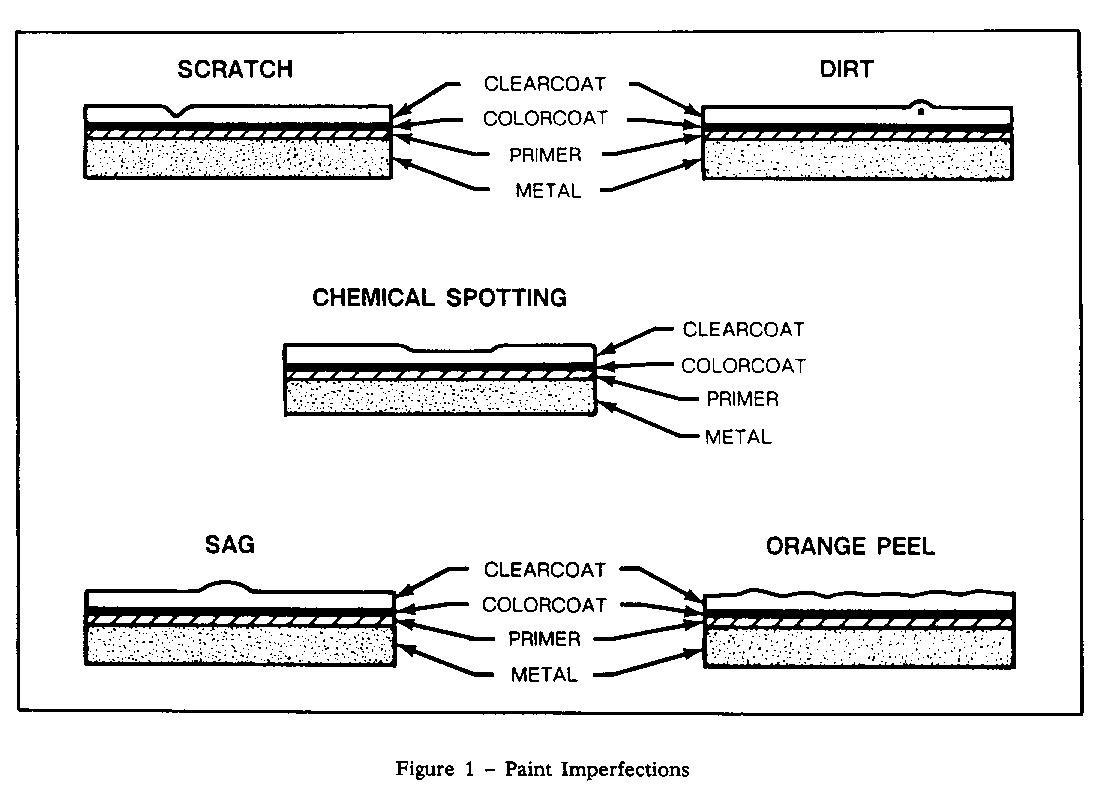REMOVAL OF CHEMICAL SPOTTING AND MINOR PAINT IMPERFECTIONS

REMOVAL OF "CHEMICAL SPOTTING" AND OTHER MINOR PAINT IMPERFECTIONS WITHOUT REPAINTING
MODELS AFFECTED: ALL 1985-1988 PONTIAC MODELS WITH BASE COAT/CLEAR COAT PAINT
This bulletin supersedes bulletin 88-10-8 dated 12/87 which should be discarded.
Some 1985-1988 Pontiac models may experience a condition of small etched spots on the horizontal surface of the paint finish clear coat.
This condition is chemical spotting and may be caused by industrial fallout (acid rain).
Chemical spotting along with other minor paint imperfections on base coat/clear coat finishes, such as sand scratches, dirt in paint, sags and orange peel can be repaired without paint application. Examples of these imperfections are shown in Figure 1.
To repair these conditions use the following procedure:
1. Wash the subject panel with water to remove any foreign material such as dirt, grit, etc.
2. Wet sand subject panel with 3M Micro-fine 1500 grit sandpaper, P/N 02023 (or equivalent). Wrap the sandpaper around a 3M rubber sponge back-up pad, P/N 005530 (or equivalent), so not to leave finger marks in the clear coat. NOTE: Always sand the length of the panel and use a mild dish soap detergent (3 to 5 drops of detergent per 16 oz. of water) in the wet sand operation for sandpaper lubricant.
3. Apply 3M Finesse-it II Finishing Material (or equivalent) to the paint surface. Spread uniformly with a 3M polishing pad #05705 (or equivalent) before starting the machining. Buff with medium pressure moving the polisher back and forth across the entire panel to ensure a uniform overall appearance. Reduce pressure as the Finesse-it II Finishing Material (or equivalent) begins to dry and buff to a high gloss finish. Spur buffing pad as needed to assist clean-up.
4. Finish polishing with a D/A (doubled action buffer) equipped with 6" foam pad and terrycloth bonnet. Wet the terrycloth bonnet with the finishing compound before polishing to prevent burning the paint.
5. Apply the Finishing Compound sparingly and evenly on the surface to be polished.
6. Keeping the polishing pad flat on the panel, polish the full horizontal length of the effected area (left to right) and use a 50% overlap on strokes. Polish the affected area again, this time moving the D/A vertically (up and down).
7. Apply 3M Imperial Hand Glaze #05990 (or equivalent) for a final cleanup and to produce an extra high gloss finish.
8. If swirl marks remain, repeat steps 6 and 7.
CAUTION:
Buffing wheels are not recommended for routine new car pre-delivery preparation of base coat/clear coat finishes.

General Motors bulletins are intended for use by professional technicians, not a "do-it-yourselfer". They are written to inform those technicians of conditions that may occur on some vehicles, or to provide information that could assist in the proper service of a vehicle. Properly trained technicians have the equipment, tools, safety instructions and know-how to do a job properly and safely. If a condition is described, do not assume that the bulletin applies to your vehicle, or that your vehicle will have that condition. See a General Motors dealer servicing your brand of General Motors vehicle for information on whether your vehicle may benefit from the information.
